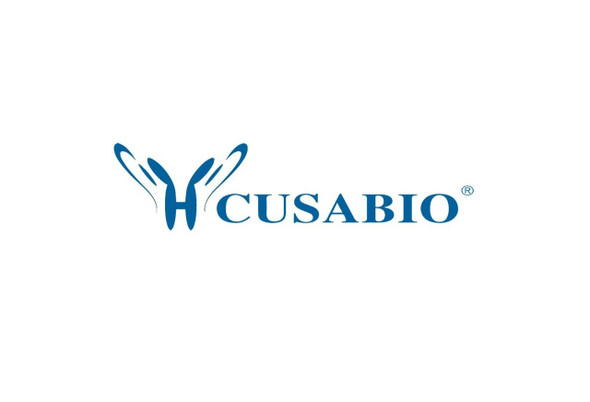Cusabio Human Recombinants
Recombinant Human Protein-tyrosine phosphatase mitochondrial 1 (PTPMT1) | CSB-EP819889HU
- SKU:
- CSB-EP819889HU
- Availability:
- 13 - 23 Working Days
Description
Recombinant Human Protein-tyrosine phosphatase mitochondrial 1 (PTPMT1) | CSB-EP819889HU | Cusabio
Alternative Name(s): PTEN-like phosphatasePhosphoinositide lipid phosphataseProtein-tyrosine phosphatase mitochondrial 1 (EC:3.1.3.16, EC:3.1.3.48)
Gene Names: PTPMT1
Research Areas: Signal Transduction
Organism: Homo sapiens (Human)
AA Sequence: KVPGRAHRDWYHRIDPTVLLGALPLRSLTRQLVQDENVRGVITMNEEYETRFLCNSSQEWKRLGVEQLRLSTVDMTGIPTLDNLQKGVQFALKYQSLGQCVYVHCKAGRSRSATMVAAYLIQVHKWSPEEAVRAIAKIRSYIHIRPGQLDVLKEFHKQITARATKDGTFVISKT
Source: E.coli
Tag Info: N-terminal 6xHis-SUMO-tagged
Expression Region: 28-201aa
Sequence Info: Full Length of Mature Protein
MW: 35.9 kDa
Purity: Greater than 90% as determined by SDS-PAGE.
Relevance: Lipid phosphatase which dephosphorylates phosphatidylglycerophosphate (PGP) to phosphatidylglycerol (PG). PGP is an essential intermediate in the biosynthetic pathway of cardiolipin, a mitochondrial-specific phospholipid regulating the mbrane integrity and activities of the organelle. Has also been shown to display phosphatase activity toward phosphoprotein substrates, specifically mediates dephosphorylation of mitochondrial proteins, thereby playing an essential role in ATP production. Has probably a preference for proteins phosphorylated on Ser and/or Thr residues compared to proteins phosphorylated on Tyr residues. Probably involved in regulation of insulin secretion in pancreatic beta cells .
Reference: Lin L., Ke R., Li H., Zhou G., Shen C., Yu R., Zhong G., Xiao W., Li M., Yang S.Human chromosome 11 DNA sequence and analysis including novel gene identification.Taylor T.D., Noguchi H., Totoki Y., Toyoda A., Kuroki Y., Dewar K., Lloyd C., Itoh T., Takeda T., Kim D.-W., She X., Barlow K.F., Bloom T., Bruford E., Chang J.L., Cuomo C.A., Eichler E., FitzGerald M.G. , Jaffe D.B., LaButti K., Nicol R., Park H.-S., Seaman C., Sougnez C., Yang X., Zimmer A.R., Zody M.C., Birren B.W., Nusbaum C., Fujiyama A., Hattori M., Rogers J., Lander E.S., Sakaki Y.Nature 440:497-500(2006)
Storage: The shelf life is related to many factors, storage state, buffer ingredients, storage temperature and the stability of the protein itself. Generally, the shelf life of liquid form is 6 months at -20?/-80?. The shelf life of lyophilized form is 12 months at -20?/-80?.
Notes: Repeated freezing and thawing is not recommended. Store working aliquots at 4? for up to one week.
Function: Lipid phosphatase which dephosphorylates phosphatidylglycerophosphate (PGP) to phosphatidylglycerol (PG). PGP is an essential intermediate in the biosynthetic pathway of cardiolipin, a mitochondrial-specific phospholipid regulating the membrane integrity and activities of the organelle. Has also been shown to display phosphatase activity toward phosphoprotein substrates, specifically mediates dephosphorylation of mitochondrial proteins, thereby playing an essential role in ATP production. Has probably a preference for proteins phosphorylated on Ser and/or Thr residues compared to proteins phosphorylated on Tyr residues. Probably involved in regulation of insulin secretion in pancreatic beta cells (By similarity).
Involvement in disease:
Subcellular Location: Mitochondrion inner membrane
Protein Families: Protein-tyrosine phosphatase family, Non-receptor class dual specificity subfamily
Tissue Specificity:
Paythway:
Form: Liquid or Lyophilized powder
Buffer: If the delivery form is liquid, the default storage buffer is Tris/PBS-based buffer, 5%-50% glycerol. If the delivery form is lyophilized powder, the buffer before lyophilization is Tris/PBS-based buffer, 6% Trehalose, pH 8.0.
Reconstitution: We recommend that this vial be briefly centrifuged prior to opening to bring the contents to the bottom. Please reconstitute protein in deionized sterile water to a concentration of 0.1-1.0 mg/mL.We recommend to add 5-50% of glycerol (final concentration) and aliquot for long-term storage at -20?/-80?. Our default final concentration of glycerol is 50%. Customers could use it as reference.
Uniprot ID: Q8WUK0
HGNC Database Link: HGNC
UniGene Database Link: UniGene
KEGG Database Link: KEGG
STRING Database Link: STRING
OMIM Database Link: OMIM










